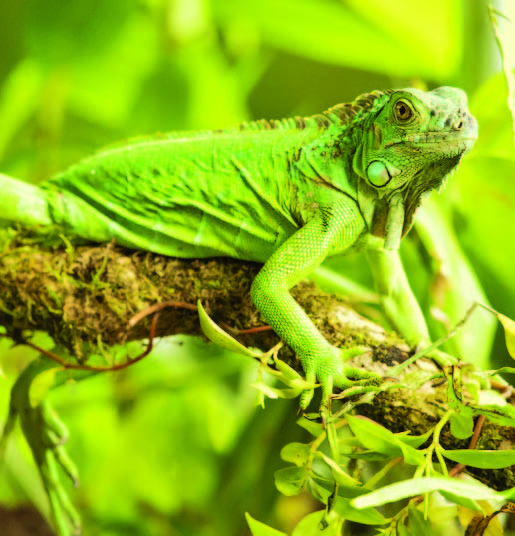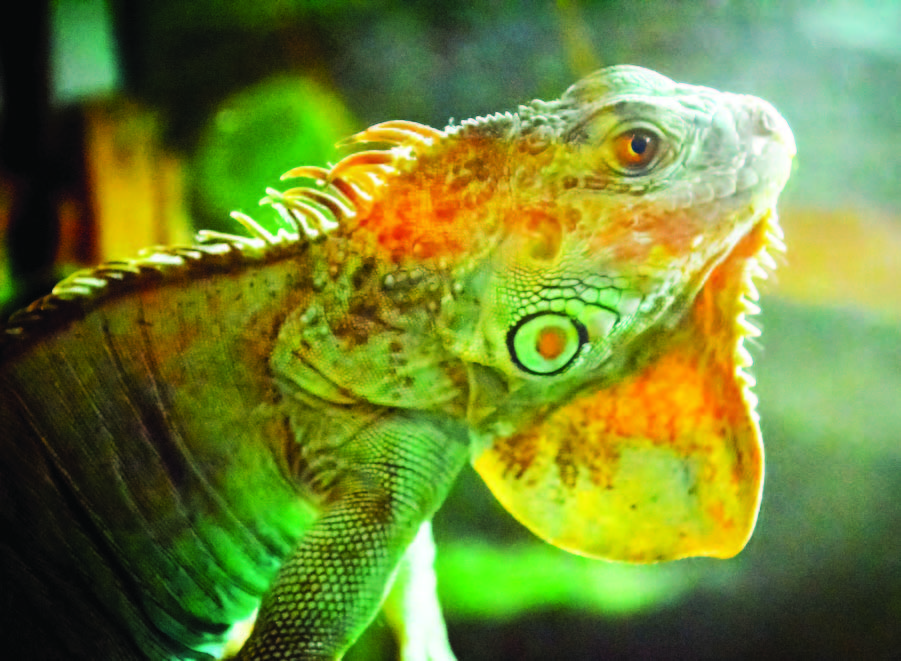Hey there, reptile enthusiasts! Let’s take a closer look at one of the most iconic and well-known reptiles around the world today: the Green Iguana (Iguana iguana). Natively found in South America and in other warm climates, the life cycle of a green iguana isn’t easy, but it is fascinating.
Laying eggs and incubating
Just like most reptiles, the typical female Iguana iguana would lay eggs every year or so, whether fertilized or not. Though the egg count per clutch varies from species to species, the common green iguana would lay around 20-60 eggs. However, only a small percentage of them would survive.

When it’s time to lay eggs roughly around 65 days after mating, the mother would travel to their preferred nesting ground, find a safe spot, bury the eggs in a warm, sunny area, cover them up with dirt, and walk away. What’s interesting is that iguana mothers won’t even bother to stay near or care for the eggs during the incubation period unlike other animals. However, there have been some claims of mothers popping back in once in a while to check on the well-being and safety of their nest.
After around 8 to 10 weeks of being buried, the baby iguanas would begin carefully cracking their eggs, resting for a brief period before slowly digging themselves out of the nest. It has been observed that some of them would poke their heads through the dirt once in a while to check for predators, making sure the coast is clear before heading out.
Hatchlings
After breaking out of their eggs, iguana hatchlings would retain their yolk sac for the next few weeks as this would supply them with the necessary nutrients. The sac would then fall off as the baby begins scavenging for food. As sad as it is, it’s common in nature for baby animals to be targeted by predators, so only a few of them actually survive long enough to reach adulthood.

Although it is a known fact that iguanas are herbivores, they do actually begin life by eating small insects and plants before slowly transitioning to mostly fruits, flowers, and greens for the rest of their lives.
As green iguana mothers don’t stick around to tend to their newly hatched babies, the tiny hatchlings are completely independent from day one. They don’t rely on anyone else, except perhaps other hatchlings from their clutch, to survive this cruel world.
Growing up
As hatchlings, they are around 6 to 9 inches long (tail included) and quickly grow to about a meter as adults. In the first two years, their growth is rapid.
Iguana iguanas are arboreal and thus live high in the trees. Surprisingly, they are excellent swimmers and are usually seen next to bodies of water. This helps them escape predators, stay hydrated, and stay in an environment that provides the humidity their body needs to shed. Coming down from the trees to swim is the best type of exercise they can get to have long, healthy lives. long, healthy lives.

Their diet consists of greens, fruits, and flowers, and their favorite hobbies include basking under the sun amongst the trees, eating leaves, laying on branches, and swimming.
During the early stages of their life, the hatchlings would pretty much look all the same: bright green with beady eyes and a slim body. Over time, they develop distinct characteristics pertaining to their sex.
The most noticeable changes between the two sexes is seen in males. Their heads start to become blockier, their jowls (flaps of skin on either side of their cheeks) start to become more pronounced, their back spikes begin to grow in length and stick upwards, and they become significantly larger than females.
As for females, while their jowls and heads do grow, it is not to the same extent as the males.
Both sexes noticeably lose their vibrant green color, but not completely. The shade turns into a dark greyish-green color, but this depends on the health and age of the iguana. They may also change color when they are stressed or sick.
As they mature, male iguanas tend to become more territorial, developing habits of head bobbing and tail whipping to show the others who’s boss. Though head bobbing is usually used as a warning signal to other iguanas or predators, it is also a way of courting females during breeding season.
Sexual maturity
Iguanas become sexually mature at one to four years of age. Some say that males take longer to reach maturity compared to females. In a secure territory, usually with more females than males, iguanas would mate during the dry season to ensure that the babies would have plenty of food to eat upon hatching during the wet season.

Iguanas are polygynandrous animals, which means both males and females may have multiple partners. It is very common between males to fight amongst each other during breeding season as they establish dominance within the group. They also tend to mark different parts of their territory (including females) with a waxy substance secreted from femoral pores.
During the act of copulation, the male would ride the back of the female and securely hold her by the shoulders, often biting the neck. He would then pair up his cloacal vent with the female’s and insert one of his hemipenes into her cloaca.
Death
Green Iguanas in the wild live for about 8 to 10 years, and ideally have hundreds of offspring. It has been reported that captive iguanas have a significantly longer life span compared to their wild counterparts because of a more monitored environment: There are no predators and they are given a balanced diet. However, some iguanas who are kept in captivity may also die earlier due to improper husbandry.
Iguanas are truly amazing reptiles. They may be hardy creatures, but we could aid their survival even more and make their life easier by working toward the preservation of the environment, even in our little ways. Happy herping!
You might want to watch:
– Iguana bonanza
– Inside an iguana: Basic anatomy
– Iggies 101: What you need to know before welcoming an iguana to your home





